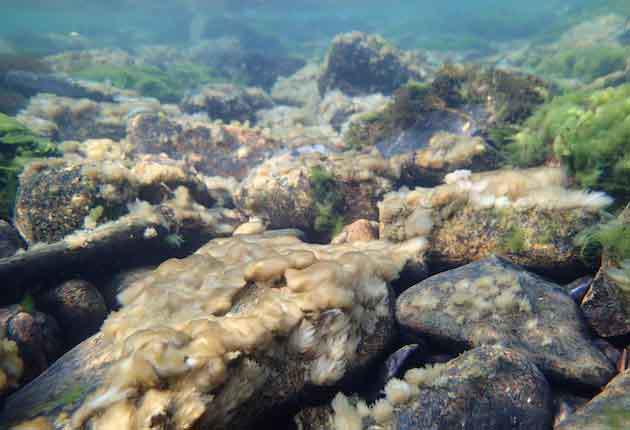North Carolina’s Wildlife Resources Commission is reminding trout anglers to clean their waders after a species of nuisance algae was found in the state’s western waters. Failing to wash and dry fishing waders after their use may not have caused didymo — Didymosphenia geminata, an algae nicknamed “rock snot” — to show up in a 2015 survey, but it could help it spread.
According to the WRC, didymo had never been found in the Tuckasegee River before 2015. Researchers from Tennessee Tech University were performing a regional survey when they came across the non-native algae, stopping to collect samples and take photos. The algae forms thick mats that stifle native vegetation and inhibit fish from moving.

“Rock snot” grows in thick mats along streambeds.
To combat the algae’s spread, the WRC is urging anglers to clean their waders and other gear before leaving the area and entering a new body of water — good advice for any fisherman, anywhere, didymo or no. Pieces of didymo can remain on boots and other contact points, hitchhiking to previously uninhabited waters and colonizing them.
Some comments on social media pointed to felt-soled wading boots as a potential carrier of didymo. While the WRC did not list them as a particulary dangerous piece of gear, their large amount of surface area can give didymo more room to cling to.
The Commission features an Angler Gear Care page on their website. Among the useful information posted there is a treatment solution for hard-to-clean equipment:
- 50 percent solution
- One part chlorine to one part water
- Dip waders into solution or wipe/spray on
- 10 percent solution
- One part chlorine to nine parts water
- Soak equipment for ten minutes
- Pour near-boiling water (200 degrees Fahrenheit) over the gear and allow to cool
Don’t throw fish remains into the water after cleaning a catch. Algal spores may be in the fish’s guts, moving into the water when discarded. Live fish should also not be moved.
“Aquatic nuisance species — either plants or animals — are organisms that cause ecological and/or economic harm if established,” said Jacob Rash, the Commission’s coldwater research coordinator. “It is important that we all work to help prevent the introduction and spread of these nuisance organisms by being good stewards of … aquatic resources that we all care for and enjoy.”
Didymo is only the latest nuisance species to enter Carolina’s trout waters. In December 2014 brook trout in the Cullasaja River were found with gill lice. Gill lice were again found, this time in Cullasaja River rainbow trout, in August 2015, and whirling disease was found for the first time in the state in Watauga River rainbows in July 2015.

